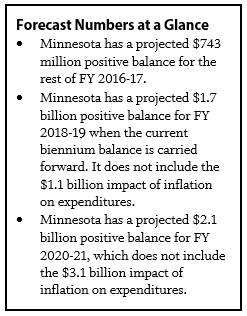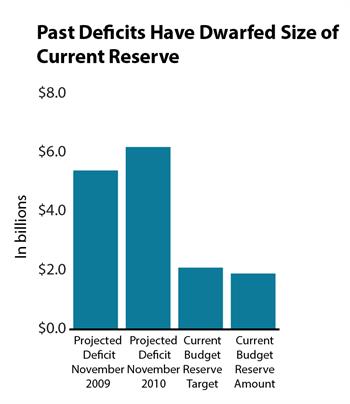The February 2017 Economic Forecast brought some fairly good news. The state of Minnesota continues to be in positive budget territory, with a $743 million positive balance for the current two-year budget cycle, FY 2016-17.[1] Minnesota also has a projected $1.7 billion positive balance for the upcoming FY 2018-19 biennium and a $2.1 billion positive balance for FY 2020-21. The national economy is also expected to improve from November’s estimates.
In the 2017 Legislative Session, policymakers will put together the budget for the upcoming FY 2018-19 biennium. These positive state budget figures are in part the result of a growing national and state economy, and they provide the opportunity to make strategic tax and budget choices that would enable more Minnesotans to get and keep quality jobs and build ladders into the middle class.
However, policymakers will be putting the budget together at a time of significant uncertainty about the timing and scope of potential federal policy changes that could have a big impact on the economy, the state’s budget and Minnesota residents. These include dramatic changes to the nation’s health care landscape and large cuts in federal funding to states. In this context, lawmakers should avoid making large and unsustainable tax cuts that would compromise the state’s ability to respond to federal changes.
Minnesota Forecast to Have Positive Balances for Three Budget Cycles

The state is projected to finish the current biennium on June 30, 2017, with a $743 million positive balance. The forecast also projects $1.7 billion to be available in FY 2018-19, including the $743 million from FY 2016-17. The FY 2018-19 figures do not include the $1.1 billion estimated cost for current levels of funding for most areas of the state budget to keep up with inflation. The forecast also gives us a first glimpse into the FY 2020-21 budget cycle. Here, the state has a $2.1 billion projected surplus, but again, this does not include the $3.1 billion estimated cost for current funding levels to keep up with inflation.
The projected surpluses are due to a number of factors. In the current biennium, tax revenues overall are expected to come in slightly higher than previously expected. This is paired with lower anticipated spending, primarily in health care and home- and community-based services. In FY 2018-19, revenues are again expected to be higher than projected in the November forecast. The forecast also projects higher spending in education and health care in FY 2018-19 than previously projected, but despite this, a surplus is still projected in FY 2018-19.
The FY 2020-21 estimates show a substantial positive balance, but the forecast cautions against reading too much into these numbers. These numbers assume that spending for most services will continue at FY 2017 levels, and only includes limited funding adjustments in response to changes in school enrollment and health care caseloads. The forecast also assumes continued economic growth throughout FY 2020-21, which would amount to over 10 years of economic growth since the last recession. In the past 50 years, the U.S. has experienced a recession every five or six years on average; such sustained economic growth into the FY 2020-21 biennium would be unprecedented.[2] And as we describe in more detail below, the forecast figures for the most part do not reflect the impact of likely federal policy changes.
The state’s economic forecasts are critical tools that policymakers and the public use to measure the state’s fiscal health and form the baseline against which spending and tax proposals are assessed. Minnesota Management and Budget prepares forecasts each November and February. State, national and global economic trends are used to estimate Minnesota’s future revenues and expenditures under current laws on taxes and spending.
For more than a decade, the official forecast figures have left out the impact of inflation on most areas of future spending. Failing to include the impact of inflation can lead policymakers to make tax and budget decisions that are not sustainable. The state’s Council of Economic Advisors recommends that Minnesota include inflation in its planning estimates so that they provide a more useful guide to policymaking.
Economic Growth Expected, But Considerable Uncertainty Means Caution Necessary
The national economy is expected to grow at a faster rate than previously projected in the November forecast. The economy is expected to grow by 2.3 percent in 2017 and between 2.1 and 2.7 percent yearly from 2018 through 2021.
The forecast shows that Minnesota’s economy is still doing fairly well. As of December, unemployment in Minnesota was 3.9 percent, still better than the national rate. Low unemployment combined with a high demand for workers continues to support a tight labor market, which the forecast expects to result in moderate wage growth.
Like any prediction of the future, this economic forecast is subject to risk. IHS Markit, the state’s macroeconomic consultant, assigns a 60 percent probability to their baseline economic forecast. They assign a 25 percent probability to their more pessimistic scenario in which there’s a short recession next year caused by “strained trade relations” and postponed investment by businesses. The forecasters also assign a 15 percent probability to a more optimistic scenario.
However, with likely large-scale changes at the federal level, the risk is likely greater. The economic forecast incorporates the projected effects on the national economy of likely reductions in individual and corporate taxes and increased spending on infrastructure. However, citing “considerable uncertainty,” the forecasters did not include any economic impact of federal decisions on trade, immigration or health care. And the projected state budget figures do not anticipate the impact of potential federal decisions on state funding or state tax revenues, although major changes are being considered.
Policymakers Should Maintain Progress Toward Broad Prosperity, Prepare for Uncertain Future
The February forecast sets the stage for making budget and tax decisions for the upcoming FY 2018-19 budget cycle. In January, Governor Mark Dayton kicked off the budget process with his budget proposal, which he updated in mid-March. Now, legislators will use this forecast to construct their tax and budget proposals. Policymakers should practice great caution as they make these decisions, as there is increased uncertainty around policy changes at the federal level, and it’s likely that the next recession is not too far away. Policymakers should focus on targeted investments that boost the ability of Minnesotans to enter the middle class, and prepare for the uncertain future by not making large and unsustainable tax cuts or weakening the budget reserve.
As required by law, the February forecast’s budgetary projections are based on current state and federal laws – they don’t anticipate likely federal changes. But the budgetary landscape is likely to change significantly.
Federal funding is a significant part of the state’s budget, and many areas of the federal budget that touch the state are under consideration for sweeping changes or funding cuts. For example, President Donald Trump has proposed deep cuts to non-defense discretionary spending that would be harmful to low-income Americans and services provided at the state and local level. The president’s budget includes $15 billion in unspecified cuts for the current fiscal year, which ends on September 30, and $54 billion in cuts for FY 2018. For example, he proposes about $18 billion in cuts to grants to states and local governments that support critical services, such as housing and poverty-reduction efforts, as well as cuts to services that build vibrant communities such as arts and humanities funding, and environmental protection activities.
In addition, major restructuring of other federal safety net programs as some in Congress have proposed could decrease Minnesota’s ability to respond to the needs of its residents. Also pending are federal tax changes that could erode the state’s ability to raise revenues.
In addition to potential federal changes, the economy itself is another area of uncertainty. Forecasters give a one in four chance that strained trade relations lead to a recession next year. During a recession, the needs of Minnesotans grow – just at the time that the resources our state relies on to meet those needs shrink.

The state’s budget reserve is critical to ensuring Minnesota can adequately respond to the next economic downturn. In the same way a family might save to be able to make it through a long illness or job loss, Minnesota keeps this reserve so when a recession hits, the state can avoid drastic cuts in essential services and continue to serve Minnesotans’ needs. During the last recession, deficits were much larger than the budget reserve, and Minnesota policymakers made painful service cuts. And a healthy level of reserves will afford state policymakers the time they need to make responsible and thoughtful budget choices in response to tough economic times, instead of having to make hasty decisions to balance the state’s budget.
In addition to maintaining a strong budget reserve, policymakers should avoid making large and unsustainable tax cuts. Making large tax cuts now will make it harder to effectively respond to what’s ahead, including federal changes. Additionally, our own state history has shown that when taxes are cut too much in surplus years, it makes it more difficult to respond to the needs of our residents in the next recession.
The February forecast brought our state some good news, but policymakers would be wise not to threaten our future with unsustainable budget and tax decisions. Instead they should make strategic investments that ensure all Minnesotans are better able to reach their full potential and ultimately strengthen the state’s economic future, and maintain the state’s ability to respond to large-scale federal changes.
By Clark Biegler
[1] Data in this analysis come from Minnesota Management and Budget, February 2017 Budget and Economic Forecast, February 2017.
[2] Minnesota Budget Project analysis of National Bureau of Economic Research data.